Creating polynomial division logical devices
a logical device and polynomial division technology, applied in the direction of cad circuit design, electric/magnetic computing, instruments, etc., can solve the problems of logic with maximum operating frequency less than desirable for real-time calculation of crcs in certain applications, data contains errors, undesirable delays, etc., to achieve the effect of improving the performance of the logical devi
- Summary
- Abstract
- Description
- Claims
- Application Information
AI Technical Summary
Benefits of technology
Problems solved by technology
Method used
Image
Examples
Embodiment Construction
[0018]FIG. 1 illustrates steps involved in creating a CRC calculating device using the prior art methodology. Firstly, a designer is provided with specifications for a desired CRC calculating device, namely the polynomial P and bus width B. Given these constraints, the designer uses a code generator to generate hardware description language (HDL) code which describes the functionality of the CRC calculating device for that specific polynomial and data-bus width combination P and B. Code generators use a range of standard programming languages such as ‘C’, Awk, Perl and Java.
[0019]The HDL code generated by the code generator is then used by a tool such as a “synthesizer” and “place and route tool” to create a configuration file for use by a machine which implements the logic procedure on the programmable target device. Accordingly, the configuration file is usually not readable by humans.
[0020]Using the prior art method, designing a CRC calculating device was at least a two step proc...
PUM
 Login to View More
Login to View More Abstract
Description
Claims
Application Information
 Login to View More
Login to View More - R&D
- Intellectual Property
- Life Sciences
- Materials
- Tech Scout
- Unparalleled Data Quality
- Higher Quality Content
- 60% Fewer Hallucinations
Browse by: Latest US Patents, China's latest patents, Technical Efficacy Thesaurus, Application Domain, Technology Topic, Popular Technical Reports.
© 2025 PatSnap. All rights reserved.Legal|Privacy policy|Modern Slavery Act Transparency Statement|Sitemap|About US| Contact US: help@patsnap.com



